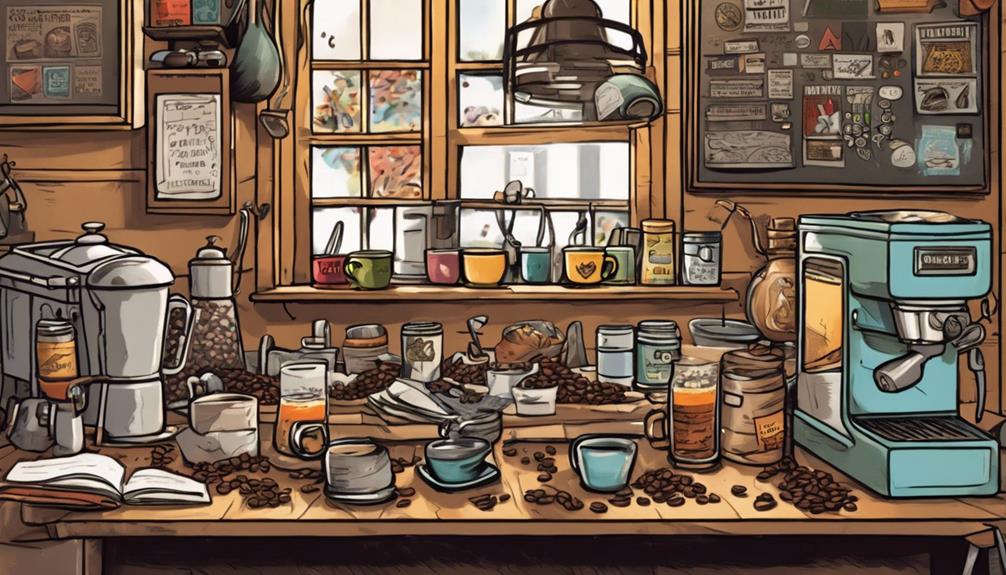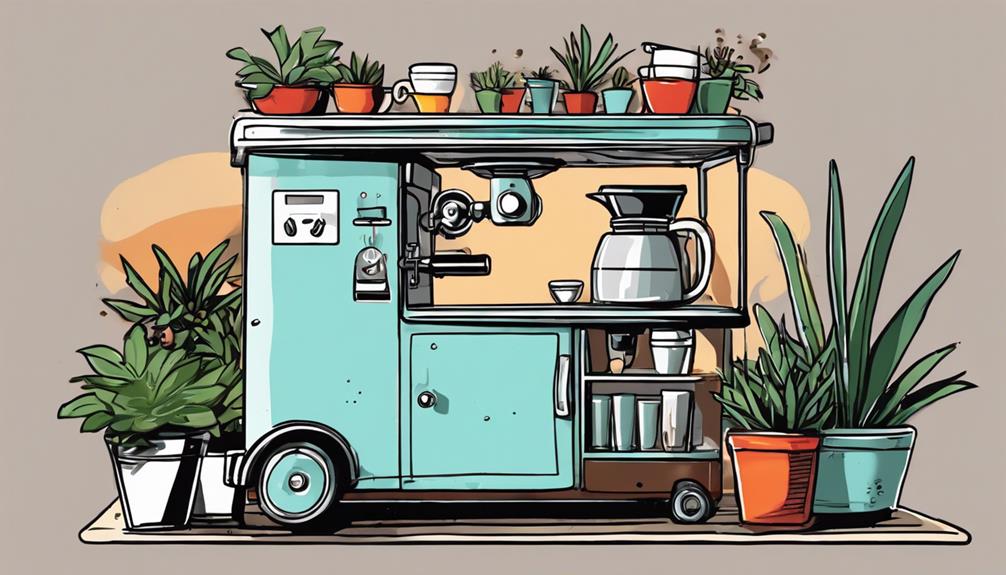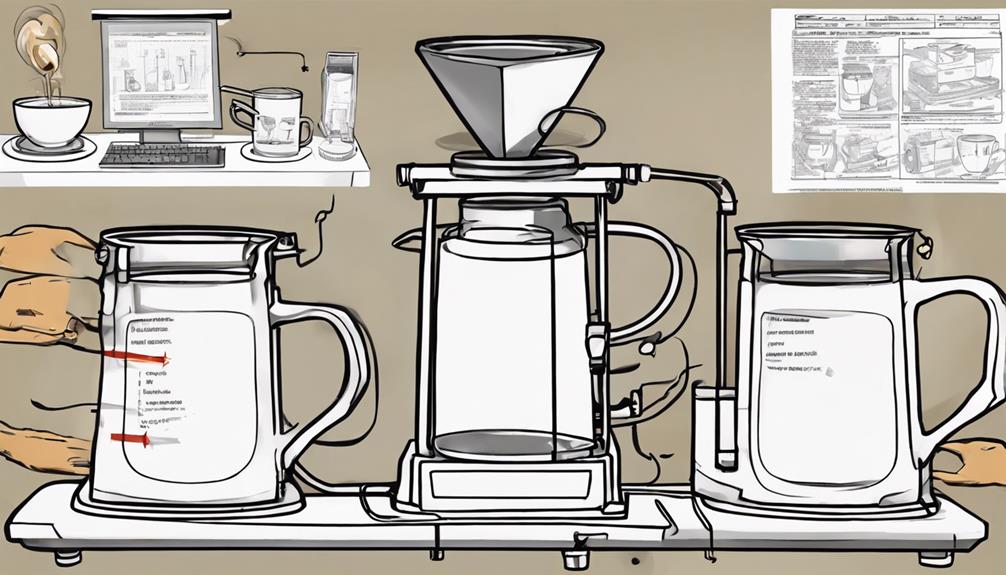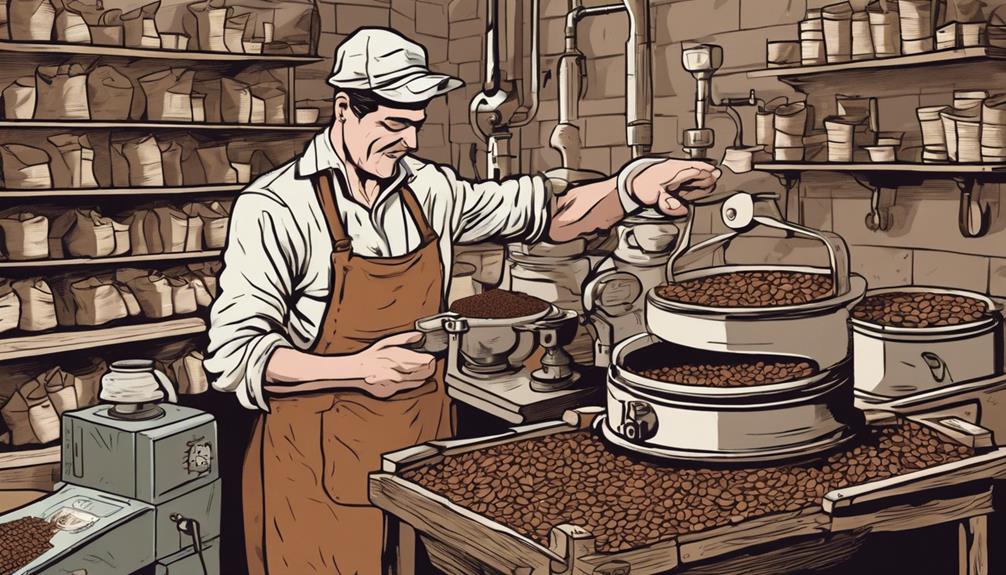Transform your home into the ultimate coffee retreat by following these steps: Select a location with access to water and electricity, incorporate vertical storage solutions, and arrange all necessary tools. Ensure you have a coffee maker, burr grinder, scale, and gooseneck kettle on hand. Select a comfortable area, establish your coffee bar, and include personal touches. Consider stylish design options like sleek white cabinets or cozy wood shelving. Stay organized with shelving units, hooks, and intelligent storage solutions. Embrace the experience of crafting your own coffee haven!
Key Takeaways
- Choose a spot near water and power sources.
- Utilize vertical storage with shelving and hooks.
- Ensure clearance for appliances in functional setup.
- Personalize with stylish design ideas like white cabinetry.
- Organize efficiently with smart storage solutions.
Location Selection
When setting up your home coffee bar, the first step is selecting the ideal location for convenience and functionality. Consider placing your DIY coffee bar near a water source and electrical outlet to make brewing your morning espresso a breeze.
Maximize your space by utilizing vertical storage options like shelving and hooks for cups, mugs, and coffee accessories. Confirm there's enough clearance for your coffee maker or espresso machine, grinder, and any other appliances you plan to include in your functional coffee station.
Think about the flow of your home and place your coffee bar in a room where it's easily accessible, such as the kitchen, dining room, or a common area. Proximity to high-traffic areas is beneficial, especially if you enjoy hosting guests and want to offer them a freshly brewed cup of coffee.
Get creative with placement options like a dedicated coffee cart or a stylish bar setup to make your coffee bar a focal point in your home.
Equipment Essentials

Consider the necessary equipment required for a functional home coffee bar, ensuring you have the tools necessary to brew your favorite coffee beverages with precision and consistency.
Here are four must-have items for your coffee bar at home:
- Coffee Maker: A reliable coffee maker is the cornerstone of your setup, whether you prefer a classic drip brewer or a sleek espresso machine.
- Grinder: Invest in a burr grinder to achieve a consistent grind size, essential for best extraction and flavor in your coffee.
- Scale: A precision scale is vital for accurately measuring your coffee grounds and water, ensuring a perfect brew every time.
- Kettle: Opt for a gooseneck kettle to have precise control over water flow, ideal for pour-over brewing methods that require a steady hand.
Setup Process Overview
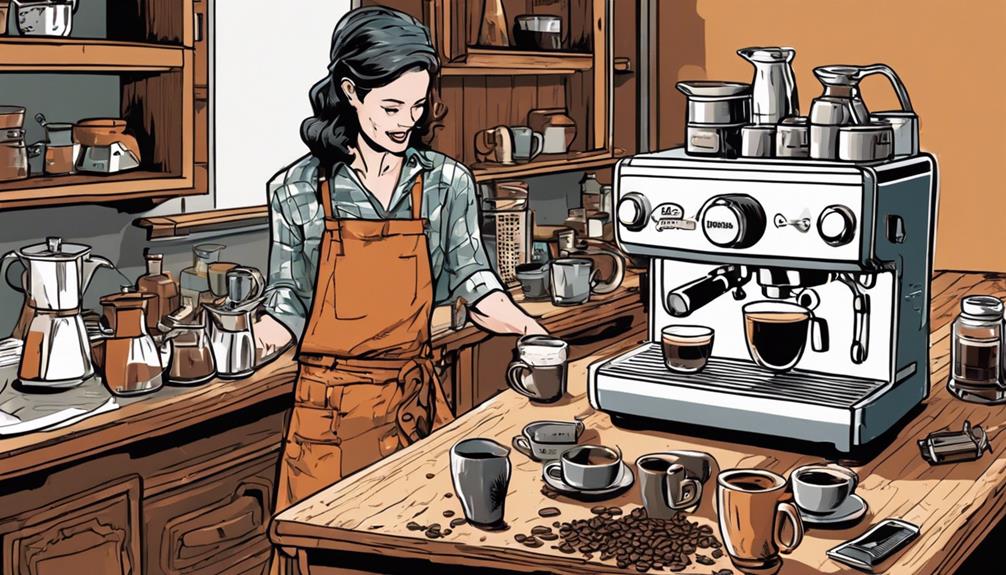
Start by outlining the step-by-step process for setting up your home coffee bar efficiently and effectively. Setting up a home coffee bar efficiently and effectively begins with gathering all the necessary equipment, such as a grinder, coffee beans, filters, and mugs. Next, designate a specific area in your kitchen for your coffee bar and organize all of your supplies in an easily accessible manner. Once everything is in place, it’s time to start assembling your Breville coffee machine.
Assembling your Breville coffee machine involves following the manufacturer’s instructions carefully and ensuring that all the components are properly connected and in working order. This step is crucial for the functionality and performance of your machine, so take your time and double-check everything before moving on to the next step.
Begin by choosing the perfect spot in your home, whether it's a corner of your kitchen, a section in your home office, or a cozy nook in your dining room. Consider creating a hidden coffee haven or a prominent coffee corner depending on your preference.
Next, set up a coffee station with all the essentials like your favorite coffee maker, grinder, kettle, and mugs. Arrange these items in a way that makes it convenient for you to use as a coffee lover. Test the layout to ensure a smooth workflow when you make yourself a cup of your best coffee.
Personalize your space with unique coffee bar ideas that reflect your style and taste. Embrace the ritual of pour-over coffee or any brewing method you prefer to enhance your at-home coffee experience.
Enjoy the process of setting up your personalized coffee bar and savor every cup you create.
Stylish Design Ideas

For a chic and functional coffee bar setup, infuse your space with sleek white cabinetry and subway tile to achieve a modern design.
To make your coffee bar area stylish and efficient, consider the following design ideas:
- Bright Colors and Glossy Finishes: Opt for bright colors and glossy finishes to create a spacious feel in your coffee station.
- Smart Storage Solutions: Maximize space with smart storage solutions that help keep your coffee bar area organized and clutter-free.
- Cozy Nook with Natural Wood Shelves: Create a cozy coffee nook in a small space by incorporating natural wood shelves for a warm and inviting touch.
- Vertical Storage with Stylish Rail System: Add vertical storage options like a stylish rail system to facilitate efficient organization of your coffee accessories while freeing up counter space.
Organizational Tips
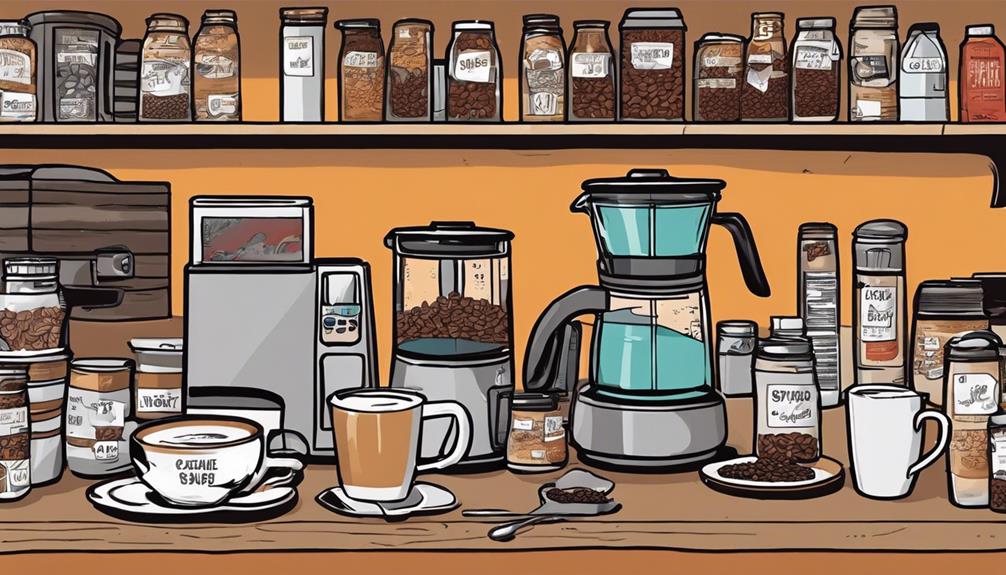
Efficiently utilize vertical space in your coffee bar by incorporating shelving and hooks for organizing your coffee accessories.
Opt for a walnut wood cabinet to create smart storage solutions, holding dishware and coffee essentials in a stylish manner.
Consider adding a rail system to your coffee bar setup; this won't only enhance the overall look but also offer a functional way to store your coffee and tea accessories.
Remember, organization is key to a well-rounded coffee bar. Accessorize thoughtfully, blending functional elements with aesthetic touches to personalize your space.
Maximize every inch by using smart storage solutions like overhead shelving and stands, ensuring a tidy and organized coffee bar where everything has its place.
Frequently Asked Questions
How to Make Your Own Coffee Bar at Home?
To make your own coffee bar at home, designate a convenient space, organize tools like a grinder and frother, set up a streamlined assembly line, and add personal touches for a cozy vibe. Enjoy your DIY coffee haven! If you find a true passion for creating your own coffee bar at home, you may even consider starting a coffee business. With your skills and knowledge of coffee preparation, you can bring your love of coffee to others by opening a small cafe or offering your personalized coffee blends for sale. The possibilities are endless once you have mastered the art of home coffee brewing.
How Tall Should a Home Coffee Bar Be?
Feeling lost about the ideal height for your home coffee bar? Aim for around 36 inches, standard countertop height. Consider comfort and accessibility for a setup that suits your needs. Customize for a perfect coffee haven!
What Should a Coffee Bar Include?
A coffee bar at home should include a coffee maker, grinder, frother, and storage solutions. Make sure to have a designated space for brewing with easy access to supplies. Enhance the aesthetics with mugs, artwork, and shelving.
How to Set up a Coffee Bar for Guests?
To set up a coffee bar for guests, designate a specific area with counter space and storage. Stock up on various coffee beans, syrups, and toppings. Provide easy access to equipment and create a visually appealing setup.
Conclusion
Now that you've got your home coffee bar set up, you're ready to brew up some delicious drinks and impress your guests.
Remember, Rome wasn't built in a day, so take your time perfecting your barista skills and enjoy the process.
Just like a fine cup of coffee, creating your coffee bar is a labor of love that will bring joy and satisfaction every time you use it.
So go ahead, sip, savor, and enjoy your new coffee oasis!
